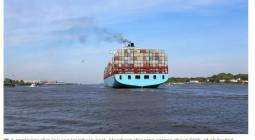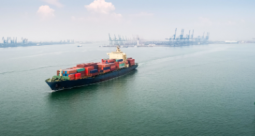Climate Regulations Are About to Disrupt Global Shipping

Ships that transport goods across oceans are collectively a major generator of greenhouse gases. Rules from the International Maritime Organization and the European Union aimed at curbing these emission promise to make transoceanic and regional shipping more expensive and reduce service, which will have a significant impact on global supply chains. Managers should begin to prepare now for this new era.
Even as companies around the world continue to struggle with the impacts of the pandemic and the war in Ukraine on global supply chains, there is another challenge looming: new environmental regulations that promise to change how shipping companies operate many transoceanic and regional routes.
New rules from the International Maritime Organization (IMO), the United Nations agency responsible for regulating global shipping, will have significant implications for how container lines design their services and will have consequences for production location choices that underpin global supply chains. Plus, European Union regulations that are likely to be passed before the end of 2022 and whose initial phase would begin in 2023 promise to add additional costs and complexity. Managers in supply chain and sourcing need to start planning for these changes.
A Major Generator of Greenhouse Gases
Maritime transport is the backbone of international trade. It is the most cost-effective way to move large volumes of goods such as oil, mineral ores, grains, and containerized cargo over long distances. But it has also attracted attention for its environmental impact: It accounts for 3% of global greenhouse gas (GHG) emissions.
The problem is that most ship engines burn heavy marine fuel oil, which produces not only carbon dioxide (CO2) but other pollutants as well. In a study published in 2015, the IMO projected that CO2 emissions associated with the sector could increase as much as 250% between 2014 and 2050 if abatement steps were not taken. Moreover, emissions are difficult to eliminate because of the need to consume large amounts of energy over long distances without the opportunities to refuel. Maritime assets have very long lifetimes — typically 25 years — so getting to net zero by 2050 will require substantial investments in near-zero fuels and propulsion technologies deployed as soon as 2030.
The IMO Rules
Beginning in January, the new IMO rules will require individual ships to measure and report a carbon intensity index in the form of an annual efficiency ratio (AER). The AER is a function of a ship’s deadweight tonnage (DWT) — how much weight it can carry in cargo, fuel, crew, fresh water, passengers, supplies, etc. — plus how much and what type of fuel it consumed and how far it traveled in the previous year. This data has been part of an IMO mandatory annual submission since 2019 for ships over 5,000 DWT.
The AER is used to grade the ship A, B, C, D, or E. Vessels that receive a grade of A, B, or C will be deemed compliant that year. Vessels graded D have a three-year grace period during which the owner will have to somehow get back into compliance, and those graded E will have one year to do so. Importantly, the grading criteria will become tougher every year: The IMO is mandating a 2% annual improvement in AER from 2023 through 2030. Thus, a ship may start with a B grade in 2023, but if no changes are made after as few as six years, it could automatically become a D. If the owner cannot comply, the vessel will have to be removed from service and likely scrapped.
The impact on container shipping, the backbone of the global merchandise trade, will be substantial. A significant number of ships will not be compliant. Most of these are older, smaller ships with less than 8,000 TEU capacity (TEU stands for 20-foot equivalent unit and is a standard container size), but the implications are serious.
Options for Achieving a Better Grade
Shipping companies have three options to improve a ship’s grade:
Switch to fuels that generate less CO2.
The fuel choice is challenging because not many fuels have the necessary energy density. Maersk, the second-largest container line by capacity, is focusing on biomethanol and has ordered 12 16,000 TEU methanol-powered ships. It has also signed agreements with several companies to produce methanol from renewable energy. CMA CGM, the third-largest container line, has made a big bet on liquified natural gas (LNG) as an interim transition fuel and plans ultimately go to some form of hydrogen. It has already put 12 LNG-powered vessels into service and will have 44 operating by 2024. Mitsui OSK Lines plans to launch 90 LNG-powered ships by 2030, and Ocean Network Express (ONE) recently ordered 10 13,700 TEU ships that could run on either ammonia or methanol. All these companies will be looking to bio-based marine fuel oil as well.
For all these strategies, a key dependency is how fast suppliers can scale up production of the massive quantities of fuel that will be needed. Originally, it was thought that LNG would have a significant advantage over the near term because it is already available in many geographies, and it is easier to handle than methanol and ammonia. But the skyrocketing prices of LNG and questions about Russian supplies due to the Ukraine war could significantly alter that equation. New LNG-powered ships will be comfortably below IMO targets for the first decade of their lifetime, but beyond that other measures will likely have to be taken such as blending with bio-based LNG or transitioning to some form of hydrogen fuel.
Change how a ship is operated.
This option is the least expensive way to keep many existing ships in compliance. Because the carbon-intensity measure is tied to how much weight is moved per unit of distance, larger vessels sailing long routes with fewer port calls will earn higher grades than smaller ships making lots of port calls. Newer and larger ships, even if not completely full, will score better than smaller ones.
Ships can slow-steam to reduce fuel consumption and hence emissions, but this also reduces the annual cargo hauling capacity of what are expensive assets and crews. Ship operators have been reducing speeds for the last decade, but the 2% annual improvement mandate means this technique will eventually reach its practical limits and older ships will have to be replaced sooner rather than later. Ports and trade lanes that cannot support high volumes may see less frequent service or the elimination of service altogether as it becomes progressively harder to serve them and remain compliant.
Make technical refinements.
These include upgrading engines and emission controls. It might include actions such as retrofitting the engine so that the ship can use alternative fuels, making changes to optimize the flow of water around the hull, or polishing or upgrading propellers.
These changes will also be expensive. Jeremy Nixon, the CEO of Ocean Network Express, a global container shipping company, estimated at a conference in January that the global container shipping industry will have to invest $1.5 trillion over the next 20 to 30 years to meet IMO targets. Even though the industry booked record profits last year, the investments it faces are enormous.
The EU’s Emissions Trading Scheme
Adding to costs, the European Union (EU) is planning to bring shipping into its Emissions Trading Scheme (ETS) in 2023. Shipping lines will have to purchase allowances for 50% of emissions for voyages connecting EU and non-EU ports. Maersk has already announced surcharges for its Asia to North Europe and North Europe to U.S. trade lanes, and others will have to follow. While a looming recession is already driving shipping costs lower, they will likely not return to their pre-pandemic levels over the longer term as the added costs ultimately have to be paid for.
The ETS is central to the EU’s climate policy and covers 40% of emissions of firms in energy-intensive sectors. It seeks to reduce GHG emissions by 61% by 2030 compared to 2005 levels. The EU’s proposed Carbon Border Adjustment Mechanism (CBAM), slated to become fully operational in 2026, will put a tax on imported products in designated sectors where production-related emissions have not been taxed at the same level by the exporter’s country. This is designed to prevent the circumvention of the EU’s GHG-reduction efforts by imports from countries with less ambitious climate policies. It will also be a critical part of phasing out of free allowances for EU producers.
While imports into Europe of products covered by the CBAM will likely decrease, exports will be impacted as well. EU-made goods that use EU ETS products as inputs will become more expensive, whether they are imported or produced in Europe. As other countries implement carbon pricing, they will need to set up similar mechanisms.
The Implications for Companies
For managers planning their supply chains, there are several important things to pay attention to:
The cost of decarbonization in ocean shipping is going to change the calculus of where goods are sourced.
Although spot market rates have declined recently, it is probably unrealistic to think that costs will return to their pre-pandemic level. While carriers plan to add a substantial amount of new capacity in the next few years, it’s tricky to forecast shipping rates because the retirement of old capacity that will have trouble meeting IMO rules will likely balance out the additions. Much will depend on whether U.S. import demand drops and carriers choose to idle ships. Other segments like bulk carriers and vessels for transporting motor vehicles may face significant challenges because there isn’t as strong an order book for new more efficient ships to replace older ones that will need to be taken out of service. High-volume trade lanes where container lines can deploy newer, larger, and more efficient assets will fare better, but all in all it may make less sense to produce many goods far away from where they are consumed even if the production costs are lower.
Lower-volume trade lanes will likely see less-frequent and higher-cost services.
This was foreshadowed during the height of the supply chain crisis in 2021, when Japan lost some direct eastbound services to North America as container lines tried to juggle capacity shortages and delays by dropping port calls from their schedule rotations. (It was a more efficient way to operate the vessels.) The IMO rules will favor efficiency: larger ships, fewer port calls, and less-frequent service with maximum capacity utilization per ship.
Companies that export to Europe or have European suppliers should plan for the higher costs that CBAM, ETS, and similar actions by other countries will produce.
Managers should anticipate that other countries outside the EU will take similar actions. For example, U.S. managers should pay attention to Canada, which has set a large increase in carbon pricing for 2030. There may be pressure for similar border adjustment measures in heavy-GHG-emitting industries such as steel.
Policies and regulations to help mitigate climate change promise to have a major impact on how supply chains are designed. Increased costs as well as the practicalities of shipping logistics are on a course for change. They will alter the way supply chains are designed and how shipping will work. Now is the time to start planning for this new era.




